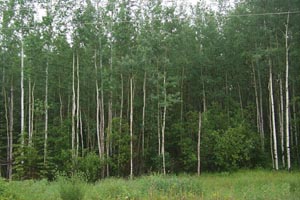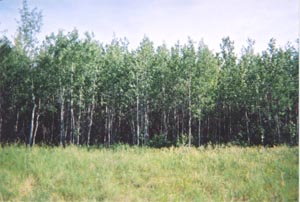| | Trembling aspen occupies the majority of woodlots in Alberta. It is important for landowners to understand the management and value of this tree species. Most woodlots are pure aspen stands or mixed wood with white spruce. To manage woodlots where aspen is dominant or the only tree species requires consideration of the following factors: biological and ecological characteristics of the forest stand, stand health, site quality, availability of markets which affects the intensity and timing of harvest operations, and harvesting methods.
Growing conditions
Aspen grows in almost every soil type but grows best in well drained, sandy or loamy soils with good moisture regime. It thrives in full sun and will not tolerate shade, or soils which are saturated for a long period of time. Aspen can act as “nurse trees” to shade tolerant softwood trees, mainly white spruce.

Mature aspen with white spruce in understory
Regeneration
Aspen is often the pioneer species and usually is the first tree species in an unoccupied area. Although, aspen produces tremendous numbers of seeds, it regenerates primarily by producing the new shoots from the root system of the parent tree. The new shoots are called root suckers and this process is called "suckering." Suckering usually occurs after a fire, harvesting and other disturbances. When the overstory canopy is removed, there is more heat and light available to the forest floor, which stimulates suckering.
In most cases aspen regenerates by suckering but some still come from seedlings. Good seed crops are produced every 4 or 5 years and some open-grown clones may produce seeds annually. Due to natural regeneration mostly from suckering, landowners should only check the amount and health of new suckers after harvesting.

Dense 10 year old aspen stand regenerated by suckering
Areas with left with a huge amount of post harvest logging slash, the tree tops and limbs, will have reduced regeneration success.
Harvesting
Many landowners ask themselves “ When is the best time to harvest aspen?” The general rule of thumb is when on aspen stand reaches maturity but before beginning to “ break up”. On very poor sites and marginal sites aspen can start “ break up” usually at 50 years of age while on better sites at 60 to 80 years of age. Because aspen is not shade tolerant, small clear-cutting (1 acre minimum) is the recommended method of harvest.
The size of clear cuts is very important. The size could be very variable though it depends on landowners goals and objectives as well as forest condition. The openings of one acre in size are the minimum acceptable for new suckering but clear-cuts of least 16-20 acres are needed for efficient harvesting. Maximum clear-cut size has no silvicultural limits and landowners should avoid large clear-cutting of their woodlots. Site preparation should be avoided as it reduces the vigor of suckers and damages the root mat. Clear-cutting maximizes regeneration by suckering and minimizing shade on the site.
In larger clear-cuts (more than 20 acres) landowners may leave standing trees for wildlife or aesthetic purposes. If the purpose is for wildlife, no more than 20 to 30 mature trees per acre should remain standing following harvest.
Winter time is probably the best time for harvesting it eliminates risk of the rutting, compaction and puddling from forest equipment. Harvesting in late spring or early summer may result in fewer suckers, than winter harvesting, but in most cases suckering is successful.
Uses
Aspen are valued not commercially for manufacture into lumber, pallets, boxes, furniture stock, pulp, paper products and oriented strand board (OSB). They are also very important environmentally as a source of food and shelter for many forms of wildlife in Alberta woodlots. Aspen like other forest types, positively affects water quality and provides settings for outdoor recreation and tourism.

Aspen flooring
Management recommendations for landowners
Management recommendation for aspen includes:
- Reduce disturbance and injury to the parent root system
- Avoid harvesting in and around sensitive areas
- Winter harvesting reduces risks of compaction, root damage and other negative risks
- Cutblocks should be an irregular shape providing more natural edge which is important for some wildlife species
- After harvesting leave snag and dead trees for wildlife habitat
- Introduce white spruce or other coniferous trees to diversify forest structure as well as age and size structure
- Encourage transition vegetation along the edges
- Through harvesting diversify age structure
- Aspen is highly intolerant on soil compaction, shade, fire damage, and mechanical roots damage and landowners should avoid, minimize or reduce it.
|
|